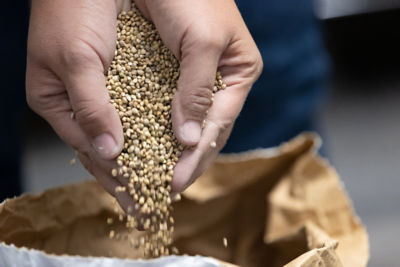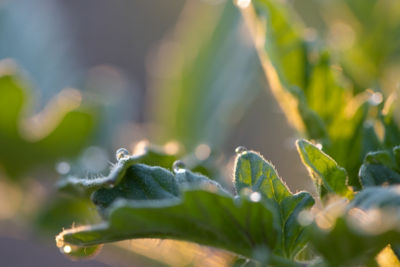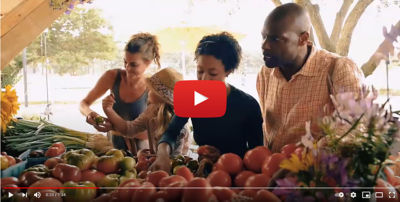Click here to download a PDF version of this spotlight.
» Angular leaf spot and Syringae blight and leaf spot are two diseases of melons and other cucurbits caused by different strains (pathovars) of the bacterium Pseudomonas syringae.
» Heavy pressure from these diseases can result in stand reductions, loss of yield, and lower product quality.
» Cultural practices and the appropriate use of bactericides can help manage these bacterial diseases of melons.
The symptoms of ALS and SBLS are similar. Initially, small, water-soaked spots develop on the leaves and cotyledons, usually near the leaf margins. As the spots get bigger, their growth is restricted by larger leaf veins and the lesions become angular in shape (Figure 1). Usually, the lesions are 1 to 5 mm in diameter. As the disease progresses, lesions turn gray or tan and may be surrounded by a yellow halo, especially on highly susceptible varieties.1,3,4,6,9 With angular leaf spot, the bacterial pathogen produces a milky film (exudate) on the surface of the lesion on the underside of the leaf. The exudate dries and forms a thin, white crust.1,2
As the lesions age, the affected tissue dies and turns brown. The tissue may crack and fall out, giving affected leaves a tattered appearance (Figure 2).6,7,8 Lesions can also form on petioles and stems. ALS lesions can form on the fruit, but fruit lesions do not usually occur with SBLS.1,10 Fruit lesions start as small (1 to 3 mm dia.), water-soaked spots with tan centers. The milky exudate and resulting white crust can also form on the fruit lesions. Early fruit infections can cause fruit to become deformed as they grow.1 Early infection of seedlings with SBLS can result in severe leaf damage and loss of transplants.9 If conditions become dry and warm, ALS and SBLS will stop spreading, and indeterminant varieties of plants can out-grow the symptoms. Low infection levels early in the season often do not result in substantial yield reductions or economic losses.1,3
 Figure 1. Angular leaf spot lesions on a melon seedling. Dan Egel, Purdue University.
Figure 1. Angular leaf spot lesions on a melon seedling. Dan Egel, Purdue University.
CYCLE AND CONDITIONS
The ALS and SBLS bacteria can be seed-borne, surviving and disseminating in infected seeds, and cotyledons can be infected during germination. The pathogens can also overwinter on infested crop debris for at least two years, as long as the infested plant tissue stays intact.1,4,8,9 Infected weed species and volunteer crop plants can also be a source of inoculum.2,6,9 In greenhouse systems, the ALS bacterium has been shown to survive on seedling trays and greenhouse surfaces.7 Infection and disease development of ALS is favored by somewhat warm 75° to 83°F (24° to 28°C) and wet conditions. Infections can occur at temperatures up to 97°F (36°C).8 In contrast, the SBLS pathogen does best in cooler (below 59°F, 15°C) and wet conditions.4,9 Most infections with the SBLS pathogen occur in the spring or late fall. Both diseases can be spread by splashing water (rain or overhead irrigation) by insects, on the hands and clothing of workers, and on equipment. The diseases spread most easily when the foliage is wet with rain, irrigation, or dew.1,4,6,9 The bacterial pathogens enter the plants through natural openings, such as stomata and hydathodes, or through wounds from insects, pruning, or blowing sand.1,2
 Figure 2. Cucumber showing the tattered leaf symptom caused by angular leaf spot. Gerald Holmes, Cal Poly San Luis Obispo, Bugwood.org.
Figure 2. Cucumber showing the tattered leaf symptom caused by angular leaf spot. Gerald Holmes, Cal Poly San Luis Obispo, Bugwood.org.
MANAGEMENT
Using only pathogen-free seed can help prevent the introduction of both ALS and SBLS into fields and greenhouses. Seed treatments can help lower the number of bacterial cells in the seed but have not been shown to eliminate them completely.1,4 Because the bacterial pathogens can survive in infested crop debris for at least two years, rotation to non-host (non-cucurbit) crops can help reduce the populations to a level where they will probably cause little, if any, damage. Plowing in crop debris promptly after harvest can help hasten the decomposition of the plant tissue and more rapidly lower pathogen populations. Crop rotation should be used in combination with good control of weed-hosts and the elimination of volunteer cucurbit plants during the rotation period.1,4,8 The use of good sanitation practices in greenhouses can help eliminate the bacterial pathogens on seedling trays, benches, and other surfaces, helping to remove sources of inoculum.7 Limit or avoid the use of overhead irrigation whenever possible to minimize pathogen spread, and avoid using irrigation water from surface water sources. Water from ponds, creeks, and rivers may contain the pathogens and be a source of inoculum.1,4,6,8 Do not allow workers or equipment to enter fields when the foliage is wet, as this is an easy way for the pathogens to spread. Also, avoid the over-application of nitrogen fertilizers that can lead to excessive growth of young susceptible tissues.8 Currently, there are no commercially available varieties of melon that have resistance to either ALS or SBLS. Although there may be some varietal variations in susceptibility to these diseases.2,4 The application of copper-based bactericides, such as copper hydroxide, can help protect plants from infection and lower the rate of pathogen spread in the field or greenhouse. For applications in the greenhouse, check product labels to make sure that the products are registered for use in those conditions. Always read the current product label for up to date information on application instructions and restrictions. In particular, pay attention to the reentry and pre-harvest (REI and PHI) intervals. Many of these products are protectant rather than systemic (eradicants), meaning that they do not penetrate or move within plant tissues. Repeated applications may be needed to protect susceptible, newly emerged plant tissues. Bactericide treatments are usually most effective under low to moderate disease pressure and may not be adequately effective when an epidemic is taking place.1,4,6,7
SOURCES
1 Zitter, T. Angular leaf spot. 2017. In Keinath, A., Wintermantel, W., and Zitter, T. (Eds.), Compendium of cucurbit diseases and pests (2nd ed., pp 69-71), American Phytopathological Society, St. Paul.
2 Kurowski, C., Conn, K., Lutton, J., and Rosenberger, S. 2015. Cucurbit disease field guide. Seminis De Ruiter.
3 Langston, D. B., Jr., Sanders, F. H., Brock, J. H., Gitaitis, R. D., Flanders, J. T., and Beard, G. H. 2003. First report of a field outbreak of a bacterial leaf spot of cantaloupe and squash caused by Pseudomonas syringae pv. syringae in Georgia. Plant Dis. 87:600.
4 Dutta, B. 2017. Syringae blight and leaf spot. In Keinath, A., Wintermantel, W., and Zitter, T. (Eds.), Compendium of cucurbit diseases and pests (2nd ed., p 78), American Phytopathological Society, St. Paul.
5 Morris, C. E., Glaux, C., Latour, X., Gardan, L., Samson, R., and Pitrat, M. 2000. The relationship of host range, physiology, and genotype to virulence on cantaloupe in Pseudomonas syringae from cantaloupe blight epidemics in France. Phytopathology 90:636- 646.
6 Aegerter, B., Davis, R., Stapleton J., and Turini, T. 2016. Angular leaf spot. UC IPM. Cucurbits Pest Management Guidelines.
7 Egel, D. 2020. Angular leaf spot of cucurbits. Purdue University, Vegetable Crops Hotline, 674.
8 Koike, S., Gladders, P., and Paulus, A. 2007. Vegetable diseases: a color handbook. Academic Press, Boston, pp 224-225.
9 Cucurbit diseases: bacterial leaf spot. U-scout. UF IFAS. https://plantpath.ifas.ufl.edu/uscout/cucurbit/bacterial-leaf-spot.html#:~:text=The%20bacterial%20leaf%20spot%20symptom,transplant%20damage%20under%20ideal%20conditions.
10 Dutta, B., Gitaitis, R. D., Driver, J. E., and Smith, S. 2016. First report of bacterial leaf spot on watermelon caused by Pseudomonas syringae pv. syringae in Georgia. Plant Dis. 100:518.
Websites verified 11/6/2023
ADDITIONAL INFORMATION
For additional agronomic information, please contact your local seed representative. Performance may vary, from location to location and from year to year, as local growing, soil and environmental conditions may vary. Growers should evaluate data from multiple locations and years whenever possible and should consider the impacts of these conditions on their growing environment. The recommendations in this article are based upon information obtained from the cited sources and should be used as a quick reference for informationabout vegetable production. The content of this article should not be substituted for the professional opinion of a producer, grower, agronomist, pathologist and similar professional dealing with vegetable crops.
BAYER GROUP DOES NOT WARRANT THE ACCURACY OF ANY INFORMATION OR TECHNICAL ADVICE PROVIDED HEREIN AND DISCLAIMS ALL LIABILITY FOR ANY CLAIM INVOLVING SUCH INFORMATION OR ADVICE.
5911_279851 Published 11/09/2023



